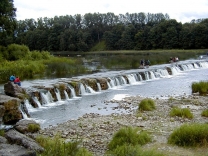No video yet

Venta Rapid
Venta Rapid (Latvian: Ventas rumba) is a waterfall on the Venta River in Kuldīga, Latvia. It is the widest waterfall in Europe at 249 metres (817 ft), and becomes as wide as 270 metres (886 ft) during spring floods. The height of the falls vary from 1.80 to 2.20 metres (5 ft 11 in to 7 ft 3 in) depending on the level of water in the river.
Geology
The waterfall is formed by Devonian dolomite and its formation is due to the difference in hardness of mineral between it lower and upper parts. Below it is more brittle and erodes faster, leaving the top layer to hang over it. These upper, more convex parts, sometimes collapse and fall into the river. As a result, the waterfall slowly recedes, and since the flow in the central zone is more powerful, waterfall middle gradually retreats higher upstream than it sides.
History
The town of Kuldiga was established here because the falls formed an obstacle on the Venta medieval inland shipping route. In the middle of the 17th century, Duke of Courland Jacob Kettler planned to dig a bypass to avoid the waterfall. Excavation starts on the right bank of the river, but the idea was abandoned because the dolomite is too hard and the work was too slow and difficult. Only in the spring high water enters the shallow canal and forms the island of Martin. According to legend, Duke ordered the waterfall demolished by explosion. After the first blast, large stone blocks dislodged and the waterfall simply changed it edge line. The power of the blast cracked walls of Duke's palace, which is close to the river, and the Duke gives up the idea.
In the 19th century Russia had plans to create a network of canals to unite all the seas of its European part. The idea was to create waterway between Baltic Sea and Black Sea across the Venta, Neman and Dnieper rivers. To implement these plans, Turkish prisoners of war were commandeered to build a canal. However it was quickly discovered that bedrock dolomite is too hard to dig in. In addition, Venta river was found not to be wide and deep enough for shipping. Construction was discontinued in 1831, however the canal...








